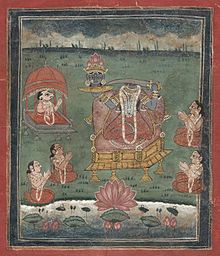Chinnamasta
Chinnamasta ( Sanskrit : छिन्नमस्ता, Chinnamastā = "whose head ( masta ) is cut off ( chinna )") is a Tantric Mahavidya in the context of Hinduism . She is said to have severed her head in a fit of self-sacrifice .
Origin and Distribution
The conceptual design of the goddess is probably based on popular religious and Tibetan Buddhist foundations, which were already widespread in the form of the Chinnamunda in the 7th century; it is also known as a form of Vajrayogini .
The worship of Chinnamasta is mainly widespread in the largely rural north of the Indian subcontinent ( Bengal , Nepal , Rajasthan ); from there it also found its way into the cities.
iconography
In iconography she mostly appears as a naked young woman with a sword in one hand and her severed head in the other. Three streams of blood flow from her throat - one into her own mouth, the other two into the mouths of the yoginis flanking her . She likes Kama , the god of sexual love, who unites with his wife Rati under her. These two lie on a lotus , which is often on a cremation site.
meaning
The iconography of the highly unorthodox and contradicting goddess combines life, death and sexuality; she feeds her followers with her own blood.
See also
literature
- Elisabeth Anne Benard: Chinnamastā - The Aweful Buddhist and Hindu Tantric Goddess. Motilal Banarsidass 2010, ISBN 978-81-208-1748-7 .
- Neela Bhattacharya Saxena, Neela (2011). "Mystery, Wonder, and Knowledge in the Triadic Figure of Mahāvidyā Chinnamastā: A Śākta Woman's Reading". In: Tracy Pintchman and Rira D. Sherma: Woman and Goddess in Hinduism: Reinterpretations and Re-envisionings. Palgrave Macmillan 2011, ISBN 978-1-349-29540-1 .
- David Kinsley: Indian Goddesses. Female goddesses in Hinduism. Insel-Verlag, Frankfurt 1990, pp. 232ff, ISBN 3-458-16118-X .
Web links
- Chinnamasta - Pictures + Info (English)
- Chinnamasta - Sculpture + Info (English)

